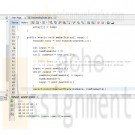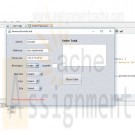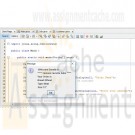Search results for 'SELECT'
-

DAT/305 Week 3 Challenge Activities 3.6.1: Hash tables with modulo hash function
Regular Price: $5.00
Special Price $3.00
DAT/305 Week 3 Challenge Activities 3.6.1: Hash tables with modulo hash function
CHALLENGE ACTIVITY 1
A hash table with non-negative integer keys has a modulo hash function of key % 20.
Hash function index range: 0 to
Item 128 will go in bucket
CHALLENGE ACTIVITY 2An ordinary array contains items with keys: 30, 22, 6, 34, 2, 10,13
A hash table has 15 buckets with hash function key % 15.
The hash table contains the same items as the array.How many elements are checked when searching for each of the following items?
CHALLENGE ACTIVITY 3An empty hash table hashTable has 5 buckets and a hash function of key % 5.
Learn More
The following operations are performed in order.
Select which operations cause a collision.
Hashinsert(hash Table, 2)
Hashinsert(hashTable, 12)
Hashinsert(hashTable, 0)
Hashinsert(hashTable, 5)
Hashinsert(hash Table, 15) -

DAT/380 Week 4 LAB 4.7 - Select number of movies grouped by year
Regular Price: $5.00
Special Price $3.00
DAT/380 Week 4 LAB 4.7 - Select number of movies grouped by year
The Movie table has the following columns:
ID - integer, primary key
Title - variable-length string
Genre - variable-length string
RatingCode - variable-length string
Year - integerWrite a SELECT statement to select the year and the total number of movies for that year.
Hint: Use the COUNT() function and GROUP BY clause
Learn More -

DAT/380 Week 4 LAB 4.6 - Select lesson schedule with inner join
Regular Price: $5.00
Special Price $3.00
DAT/380 Week 4 LAB 4.6 - Select lesson schedule with inner join
The database has three tables for tracking horse-riding lessons:
Horse with columns:
ID - primary key
RegisteredName
Breed
Height
BirthDateStudent with columns:
ID - primary key
FirstName
LastName
Street
City
State
Zip
Phone
EmailAddressLessonSchedule with columns:
HorseID - partial primary key, foreign key references Horse(ID)
StudentID - foreign key references Student(ID)
LessonDateTime - partial primary keyWrite a SELECT statement to create a lesson schedule with the lesson date/time, horse ID, and the student's first and last names. Order the results in ascending order by lesson date/time, then by horse ID. Unassigned lesson times (student ID is NULL) should not appear in the schedule.
Hint: Perform a join on the Student and LessonSchedule tables, matching the student IDs.
Learn More -

DAT/380 Week 3 LAB 3.16 - Select horses with logical operators
Regular Price: $5.00
Special Price $3.00
DAT/380 Week 3 LAB 3.16 - Select horses with logical operators
The Horse table has the following columns:
ID - integer, primary key
RegisteredName - variable-length string
Breed - variable-length string
Height - decimal number
BirthDate - dateWrite a SELECT statement to select the registered name, height, and birth date for only horses that have a height between 15.0 and 16.0 (inclusive) or have a birth date on or after January 1, 2020.
Learn More -

DAT/380 Week 2 LAB 2.10 - Select employees and managers with inner join
Regular Price: $5.00
Special Price $3.00
DAT/380 Week 2 LAB 2.10 - Select employees and managers with inner join
The Employee table has the following columns:
ID - integer, primary key
FirstName - variable-length string
LastName - variable-length string
ManagerID - integer
Write a SELECT statement to show a list of all employees' first names and their managers' first names. List only employees that have a manager. Order the results by Employee first name. Use aliases to give the result columns distinctly different names, like "Employee" and "Manager".Hint: Join the Employee table to itself using INNER JOIN.
Learn More -

DAT/380 Week 2 LAB 2.9 - Select movie ratings with left join
Regular Price: $5.00
Special Price $3.00
DAT/380 Week 2 LAB 2.9 - Select movie ratings with left join
The Movie table has the following columns:
ID - integer, primary key
Title - variable-length string
Genre - variable-length string
RatingCode - variable-length string
Year - integer
The Rating table has the following columns:Code - variable-length string, primary key
Description - variable-length string
Write a SELECT statement to select the Title, Year, and rating Description. Display all movies, whether or not a RatingCode is available.Hint: Perform a LEFT JOIN on the Movie and Rating tables, matching the RatingCode and Code columns.
Learn More -

PRG/421 Week 5 Java 5.20 LAB: Descending selection sort with output during execution
Regular Price: $7.00
Special Price $3.00
PRG/421 Week 5 Java 5.20 LAB: Descending selection sort with output during execution
Write a void method selectionSortDescendTrace() that takes an integer array, and sorts the array into descending order. The method should use nested loops and output the array after each iteration of the outer loop, thus outputting the array N-1 times (where N is the size). Complete the main() to read in a list of up to 10 positive integers (ending in -1) and then call the selectionSortDescendTrace() method.
If the input is:
20 10 30 40 -1then the output is:
Learn More
40 10 30 20
40 30 10 20
40 30 20 10 -

ITSD424 Unit 3 Famous Favorite Subs
Regular Price: $10.00
Special Price $8.00
ITSD424 Unit 3 Famous Favorite Subs
Continuing from the last assignment.
Assignment DetailsPart 1
Modify your Java application so that it is an easy-to-use GUI application where all of the interaction is performed on one screen. You will now take the individual components and translate them to a single interactive GUI interface using the following GUI components, container, the event listeners, and event subclasses to enhance your application as a more GUI-appropriate interface:
• GUI components
• Container
• Event listeners
• Event subclasses (at least 3–4 utilized)
o ActionEvent
o ItemEvent
o FocusEvent
o KeyEvent
o MouseEvent
o WindowEvent
• ActionPerformed MethodPart 2
Learn More
For this assignment, you are being asked to make sure you are exception handling by verifying that all of the customer-entered information is valid before the order is submitted to ensure order accuracy.
The customer information that the customer must now enter that should be validated includes the following:
• Entered username (must fill in a name)
• Entered at least one sub to order
• Selected all three attributes for sub (such as bread type, sub type, and sub size)
• Entered delivery address that includes street, city, state, and zip code
• Entered telephone number xxx-xxx-xxxx
In this assignment, you are adding in error handling to make sure the customer is filling in all of the required information.
To accomplish this task, you will be utilizing the following Java classes:
• Methods in the character class and StringBuilder class to validate and manipulate characters in a string
• Try.. Catch for the exception handling of all input fields -

ITSD424 Unit 1 Famous Favorite Subs
Regular Price: $10.00
Special Price $8.00
ITSD424 Unit 1 Famous Favorite Subs
We are developing this application
1. User will choose from menu item
2. User will review ordered items
3. Each item will have a unit price
4. Order details will show unit price plus total price
5. Use will Press order button to place order
For this Unit
Assignment Description
At this point, you are ready to start developing Java code to ask questions on customer information and the sub sandwich that customers want to order. You are only concerned with the functionality to request and provide feedback on what the customer entered.
Your main focus is on defining your classes and abstract classes and utilizing the concept of inheritance and polymorphism for the final sub the customer orders. You will first prompt for the customer name and delivery address, like in this sample that prompts for the customer name:Then, you will prompt for the beverage, sub bread, sub type, and sub size.
You should present a message echoing back all of the information that the customer entered, similar to the following example presenting the customer’s name with a message:Make sure you prompt for the four attributes (beverage, bread, type, and size) that you will need to request from the customer to define for the final sub and beverage selection. Also, be sure to comment all of your code to demonstrate that you understand what the code is doing.
Learn More -

CIS355A Week 4 Lab - Processing Arrays of Objects Stocks4U
Regular Price: $12.00
Special Price $10.00
CIS355A Week 4 Lab - Processing Arrays of Objects Stocks4U
OBJECTIVES
• Create a GUI that uses JList and JTabbedPanes.
• Process multiple objects in an ArrayList.
• Code event handlers for multiple events.PROBLEM: Stocks4U Portfolio Management System
Stocks4U needs to develop an app for you to manage your stock purchases. You should be able to store a list of stock purchases, view the individual stocks, add and remove stocks.FUNCTIONAL REQUIREMENTS
You can code the GUI by hand or use NetBeans GUI builder interface.The GUI should have two tabs using JTabbedPane.
• One tab ("Show stocks") should have
o a JList to display all the stock purchases;
o a text field or label to display information about a particular stock; and
o a JButton to remove a stock.
• One tab ("Add stock") should have textboxes, labels, and a button to input a stock.Create a Stock class to manage the stock activity. It should have private instance variables of
• company name;
• number of shares;
• purchase price; and
• current price.
Create a default and parameterized constructor.
Create sets/gets for all instance variables.
Create a get method to calculate and return the profit or loss. This would be calculated as
Number of shares * (current price – purchase price).
Create toString to display the name of the stock.As you add stocks, they are displayed in the JList.
If you select an element in the JList, the gain or loss is displayed in the label or text field.
If you select an element in the JList and click Remove, the stock is removed from the list.GRADING RUBRIC
Stock class
• Has all required functionality 15
GUI class
• Use the Stock class to process data.
• As you add stocks, they are displayed in the JList.
• If you select an element in the JList, the gain or loss is displayed in the label or text field.
• If you select an element in the JList and click Remove, the stock is removed from the list.
• Use error messages for any invalid/missing user input using JOptionPane. 25
Code style 5
Lab Report 10
TOTAL 55CODE STYLE REQUIREMENTS
• Include meaningful comments throughout your code.
• Use meaningful names for variables.
• Code must be properly indented.
• Include a comment header at beginning of each file, example below.
/****************************************************
Program Name: ProgramName.java
Programmer's Name: Student Name
Program Description: Describe here what this program will do
***********************************************************/DELIVERABLES
Submit as a SINGLE zip folder
• All java files
• Lab reportFollow assignment specification regarding class/method names.
Learn More
Note that your java filename must match class name (DO NOT rename).




